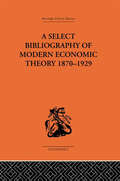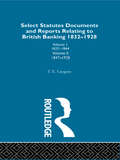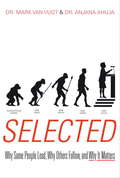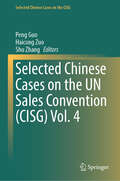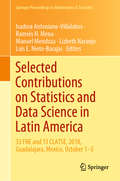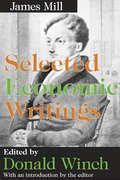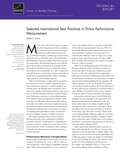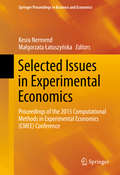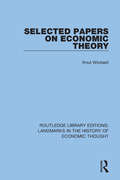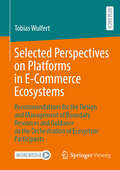- Table View
- List View
Selbstorganisation in der Praxis: Erfahrungen von Unternehmen aus der Sozialwirtschaft
by Vanessa Kubek Regina Osranek Viola Hellge Judith HoffmannDieser Sammelband beschreibt die Grundlagen selbstorganisierten Arbeitens, v.a. Werte, Haltungen, Organisationsmodelle, Führungsansätze und Zusammenarbeitstechniken. Er zeigt konkrete Umsetzungswege auf, die von Einrichtungen der Sozialwirtschaft beschritten wurden. Dabei wird ein vielfältiges Spektrum gezeichnet: Von der Gestaltung eines energiestiftenden Auftakts des Organisationsentwicklungsprozesses, über konkrete Veränderungen in den Bereichen Kundenorientierung, Führung, Zusammenarbeit, arbeitsorganisatorische Maßnahmen hin zu wichtigen Detailthemen wie Wertschätzung und Feedback mündet der Band in einer kritischen Reflexion, wieviel Ausdauer der Weg in Richtung „mehr Selbstorganisation“ erfordert. Den Abschluss bildet ein Interview mit Führungskräften aus den Unternehmen der Sozialwirtschaft, die im Buch beispielhaft illustriert werden, und die von ihren persönlichen positiven wie auch herausfordernden Erfahrungen berichten. Die praktischen Beispiele zeigen, dass die Wege in Richtung Selbstorganisation vielfältig sind. Sie sollen Einrichtungen der Sozialwirtschaft anregen, ihre eigenen Wege zu gehen.
Selbstorganisiertes Lernen im Unternehmen
by Werner BünnagelDieses Buch will auf ein neues berufliches Lernen vorbereiten, denkt Fortschritte voraus und zeigt neue Wege in die Zukunft auf. Es ist ein Leitfaden für selbstorganisiertes Lernen. Mit praxiserprobten Tipps und mit ganz pragmatischen Handlungsempfehlungen.
Select: Jumpstart the Cycle of Excellence-Encourage Peak Performance by Putting the Right Person in the Right Job
by Heather Beckham Edward M. Hallowell John A. QuelchAs General Electric CEO Jack Welch said, "Getting the right people in the right jobs is a lot more important than developing a strategy." Smart managers know that job fit means paying attention to three things: what a person likes to do most; what he or she does best; and what adds the greatest value to the project or organization. In this chapter, bestselling author ("Driven to Distraction") and practicing psychiatrist Edward Hallowell focuses on "Select," the first of five steps in the Cycle of Excellence. He uses real-life examples to demonstrate the importance of fit-that when there's a mismatch between the employee and the job, everything that follows, no matter how fervent the effort, suffers. He also explains how to recognize a bad fit and what to do to fix it. The chapter offers practical steps you can take today-including the "Hallowell Self-Report Job-Fit" questionnaire-that will help you identify your employees' strengths and interests and match them to the particular challenges of your organization. The chapter concludes with a discussion of "conative style"-defined as an individual's natural, inborn style of solving a problem-and how understanding this characteristic in each of your employees can help you put the right person in the right job. This chapter was originally published as Chapter 2 of "Shine: Using Brain Science to Get the Best from Your People."
A Select Bibliography of Modern Economic Theory 1870-1929
by Harold E. BatsonA bibliography of this kind has long been needed. The book is clearly and accurately printed and well arranged." Times Literary Supplement. The scope of the bibliography is economic theory between 1870-1929, the heyday of the neo-classical revolution. The first part of the work is a series of select bibliographies of the different branches of theory. The second part covers a series of bibliographies of the works of key authors. * Bibliography covers American & English publications and German, French and Italian sources. * Subjects covered include: International Trade, Risk, Supply & Demand, Competition & Monopoly, Taxation and Public Expenditure.
Select Documents in Canadian Economic History 1783-1885
by Harold Innis Arthur LowerThis second volume of economic documents resumes the story of the development of Canada as told by contemporary sources. Newspaper accounts of economic forces and factors, contemporary writings by statesmen and business men, poems depicting current situations, official documents—all have been included. The volume divides the period into two eras, 1783-1850 and 1850-85. The basis of classification of entries is by topics and geographic sections. It is hoped that the material which follows will amplify and illustrate the blend of materialistic and non-materialistic factors which has determined the nature of Canadian history and will allow students in Canadian universities to study with some degree of fullness the development of the economic institutions of their native land.
Select Statutes, Documents and Reports Relating to British Banking, 1832-1928
by T. E. GregoryFirst Published in 1964. This is Volume I of two that forms a collection of select statues documents and reports around the banking industry within Britain from 1832 to 1928. This volume includes up to 1844, looking at the state of banking before The Act of 1844 and also the Bank Charter Act.
Selected
by Mark Van Vugt Anjana AhujaA groundbreaking, evolutionary science-based exploration of the history of leadership that explains how and why some men and women evolve into good or great leaders, and some do not.We are all leaders or followers -- or both. We can recognise leadership in almost every area of life: in the workplace, among friends, within families, in politics and religion. But what makes a good or bad leader, and what makes an outstanding one? Selected examines how and why leadership has evolved over tens of thousands of years, and presents a bold and compelling new "mismatch hypothesis": the slowness of evolution means that there is a mismatch between modern leadership and the kind of leadership that our Stone Age brains are still wired for. This makes for all sorts of tendencies, problems and solutions that no author has yet discussed but that affect all aspects of our lives.Full of fascinating examples drawn from a diverse range of spheres, from politics and commerce to sport and culture, Selected explains why taller political candidates usually win, why women chief executives attract such hostility, why we like it when the boss asks after our children and what prime ministers and presidents can do to improve their chances of electoral success.This is the first book of its kind -- reaching into business, psychology, politics and current affairs -- to explore how leadership affects us all. It also offers the first truly scientific theory of leadership: where previous books have provided anecdote, it details empirical evidence. Selected provides deep insight into our personal and professional lives at a time when the world urgently needs to acknowledge great leadership.From the Hardcover edition.
Selected Chinese Cases on the UN Sales Convention (Selected Chinese Cases on the CISG)
by Peng Guo Haicong Zuo Shu ZhangThis book focuses on Chinese cases on the CISG decided by Chinese courts of all levels, focusing on those decided from 2013 to 2016. During this period, the number of cases grew fast compared to 2010 to 2012 covered in volume 3. The growth in the total number reflects that parties might become more familiar with the CISG and therefore decided not to opt out of it; in addition, the case collection and report systems in China at that time were developing very fast, rendering many cases easily accessible. This book provides a comprehensive and detailed analysis of selected cases. The analysis of those cases will be on a case-by-case basis. For each case, an English summary of the judgment will be provided. In the comment, the People’s Courts’ approach to the interpretation and application of the CISG will be discussed. Comments of the individual case will be written either by scholars, or judges or lawyers from international and comparative perspectives to discuss the successes and pitfalls of the interpretation and application of the CISG in China. These selected cases reflect how People’s Court of all levels started to deal with various issues arising from the CISG and will help understand whether and how the People’s Courts change their approaches to the interpretation and application of the CISG in the future.
Selected Commercial Statutes 2011
by Carol L. Chomsky Christina L. KunzThis product provides a collection of uniform laws and federal statutes for use in all commercial law courses. It begins with the most widely used version of the Uniform Commercial Code, consisting of the 2009 version of Articles 1 and 3-9 and the 2002 version of Articles 2 and 2A. Appendixes contain the Permanent Editorial Board commentaries, as well as earlier versions of Articles 1, 3, 4, and 7, and the 2003 and 2005 amendments to Articles 2 and 2A, in underline-strikeout form with the Official Comments. It also includes additional uniform laws and significant federal commercial legislation and regulations.
Selected Contributions on Statistics and Data Science in Latin America: 33 FNE and 13 CLATSE, 2018, Guadalajara, Mexico, October 1−5 (Springer Proceedings in Mathematics & Statistics #301)
by Isadora Antoniano-Villalobos Ramsés H. Mena Manuel Mendoza Lizbeth Naranjo Luis E. Nieto-BarajasThe volume includes a collection of peer-reviewed contributions from among those presented at the main conference organized yearly by the Mexican Statistical Association (AME) and every two years by a Latin-American Confederation of Statistical Societies. For the 2018 edition, particular attention was placed on the analysis of highly complex or large data sets, which have come to be known as “big data”. Statistical research in Latin America is prolific and research networks span within and outside the region. The goal of this volume is to provide access to selected works from Latin-American collaborators and their research networks to a wider audience. New methodological advances, motivated in part by the challenges of a data-driven world and the Latin American context, will be of interest to academics and practitioners around the world.
Selected Decisions and Selected Documents of the International
by International Monetary FundA report from the International Monetary Fund.
Selected Decisions and Selected Documents of the International Monetary Fund
by International Monetary FundA report from the International Monetary Fund.
Selected Economic Writings
by James MillJames Mill was the consummate utilitarian economist and theorist: his numerous intellectual interests and practical pursuits shatter the net boundaries of modern specialist scholarship in social science.Mill's many-sided genius was primarily a product of the age in which he lived. The late eighteenth and early nineteenth centuries saw a remarkable flowering of intellectual genius in Scotland in all of the arts and sciences, which gave the country a leading place in the broad European movement known as the Enlightenment, Mill being in fact only one of many brilliant men Scotland produced at that time.Mill's writings in this volume, first published in 1966, cover his development as an economist and are an attempt to assess his contribution to classic political economy. Particular attention is paid to the formative but less well-known pre-Benthamite period of his life. The volume opens with a substantial biographical assessment of Mill's life and work. The selections are specifically divided into four groups consisting of: early economic writings (""An Essay of the Impolicy of a Bounty on the Exportation of Grain,"" ""Commerce Defended,"" and ""Smith on Money and Exchange""); James Mill and David Ricardo (""Elements of Political Economy""); Mill on scope and method (""Whether Political Economy is Useful""); and Mill and India (""History of British India""). Donald Winch provides an introduction to each section that contextualizes the essays in Mill's own work and the economic thought of the time.James Mill: Selected Economic Writings is sure to be of interest to students of economic theory and social policy. One of the founders of utilitarianism, he adopted that doctrine to both British conditions and Britain's broader imperial pursuits.Donald Winch is professor of economics at the University of Sussex. He has authored and edited many books and papers on economics, economic theory, economic policy and economic history.
Selected Essays in Monetary Economics (Collected Works of Harry G. Johnson)
by Harry JohnsonThis volume consists of selected previously published key essays which have proved most useful for teaching advanced monetary economics. A short introduction was added which places the selection of essays and the issues they cover in the contemporaneous context of simultaneous high inflation and high unemployment. As relevant today as they were when they were first written, they enable the reader to anticipate intelligently what is likely to happen and why.
Selected International Best Practices in Police Performance Measurement
by Robert C. DavisHistorically, police agencies have measured their performance against a restricted set of crime-focused indicators, but modern police officers must be prepared to take on a wide variety of roles. Performance measures should be multidimensional to capture this complexity. This report describes some key considerations in designing measures to evaluate law enforcement agencies and includes a detailed review of some international best practices.
Selected Issues in Experimental Economics
by Kesra Nermend Małgorzata ŁatuszyńskaTheaim of this volume is to provide deep insights and the latest scientificdevelopments and trends in experimental economics. Derived from the 2015Computational Methods in Experimental Economics (CMEE) conference, this bookfeatures papers containing research and analysis of economic experimentsconcerning research in such areas as management science, decision theory, gametheory, marketing and political science. The goal is to present possibilitiesfor using various computer methods in the scope of experimental economics tofurther provide researchers with a wide variety of tools. Thefield of experimental economics is rapidly evolving. Modern use of experimentaleconomics requires the integration of knowledge in the domains of economicsciences, computer science, psychology, and neuroscience. Recent researchincludes experiments conducted both in the laboratory and in the field, and theresults are used for testing and a better understanding of economic theories. Researchers working in this field use mainly a set of well-established methodsand computer tools that support the experiments. Methods such as artificialintelligence, computer simulation and computer graphics, however, are notrepresented enough in experimental economics studies and most experimenters donot consider their usage. The goal of the conference and the enclosed papers isto allow for an exchange of experiences and to promote joint initiatives toinsight change in this trend.
Selected Papers from the 10th International Conference on E-Business and Applications 2024
by Pui Mun Lee Gyu Myoung LeeThis book brings together original, peer-reviewed research papers from the 2024 10th International Conference on E-Business and Applications, held in Singapore from February 26 to 28, 2024. The papers delve into AI-enabled business innovation, data-driven value creation, and the emerging IoT landscape, providing in-depth insights into these rapidly evolving fields. The book bridges the gap between business intelligence, artificial intelligence, and e-commerce trading technologies, offering a holistic perspective on the intersection of these disciplines. Readers can gain valuable knowledge through real-world examples, data visualization techniques, and business analytics applications, enhancing their understanding of how these concepts translate into tangible business outcomes.
Selected Papers from the Asia Conference on Economics & Business Research 2015
by Stanley SohThe book is a compilation of selected papers presented at the Asia Conference on Economics & Business Research in 2015. The peer-reviewed contributions cover topics such as microeconomics, macroeconomics, financial economics, accounting and economics, organizational behavior, marketing, business ethics, general management, strategic management, operations management and public sector management. The volume serves as a valuable resource for researchers and practitioners in the area of economics and business research in Asia.
Selected Papers from the Asia-Pacific Conference on Economics & Finance (APEF #2016)
by Evan Lau Lee-Ming Tan Jing Hee TanThis book features the best papers presented at the Asia-Pacific Conference on Economics & Finance in 2016. Chapters include research conducted by experts in the field of Economics, Finance and Business from the region. Put together by East Asia Research, East Asia Institute of Management & Universiti Malaysia Sarawak (UNIMAS) , this book serves as a useful resource for educators, researchers, thought leaders, policy makers, and economists.
Selected Papers on Economic Theory (Routledge Library Editions: Landmarks in the History of Economic Thought)
by Knut WicksellThis volume, originally published in 1958, contains a selection of the most important and interesting articles by Knut Wicksell, which had hitherto only been published in Swedish. They cover Wicksell’s views on Economics and monetary theory, his theory of production and distribution, some review articles on the works of Pareto, Böhm-Bawerk, Carl Menger and Bowley and some papers on foreign trade problems, written after the First World War. Erik Lindahl’s introductory essay gives a picture of Wicksell the social reformer, who radical opinions often brought him into conflict with the authorities and the general public.
Selected Payout Products of the Old-Age Pension Saving Scheme (SpringerBriefs in Statistics)
by Jana Špirková Igor Kollár Gábor Szűcs Pavel ZimmermannThis book discusses the payout phase of the old-age pension saving scheme, the so-called effective premium, and offers detailed actuarial models and analyses of five old-age pension saving products used in practice. These include the basic permanent monthly annuity, without any benefits for survivors, as well as products which, in addition, also include benefits for survivors or authorized persons in the event of the pensioner’s death. The purpose of the book is to point out the method of determining future old-age pensions from old-age pension savings, and to present the advantages and disadvantages of such a pension. The book also emphasizes the role of the profitability testing of the products and answers questions concerning the effectiveness of old-age pension savings and insurance. The book is primarily intended for students of actuarial and financial mathematics and future economists.
Selected Perspectives on Platforms in E-Commerce Ecosystems: Recommendations for the Design and Management of Boundary Resources and Guidance on the Orchestration of Ecosystem Participants
by Tobias WulfertDigital platforms hold significant economic value, enriching various industry sectors. While they are pivotal in driving value creation and capture, it is not solely their technological prowess that underpins their economic significance. Rather, their effectiveness lies in their integration within business ecosystems. In this study, Tobias Wulfert examines digital platforms in the context of e-commerce through five lenses: · Enterprise architecture · Boundary resources · Application lifecycle · Dynamic capabilities · Value creation This analysis focuses on different e-commerce platform types, developing an architectural framework and a taxonomy for classification. The author also delineates e-commerce ecosystem architectures, emphasizing the role of platforms as central components and the involvement of peripheral ecosystem participants. He explores boundary resources as crucial interfaces between platforms and ecosystem participants. He further suggests a reference procedure model for the management of these boundary resources. Furthermore, he delves into the dynamic capabilities necessary for effective ecosystem orchestration, identifying configurations of dynamic capabilities that can confer sustainable competitive advantages.
Selected Proceedings of the 1st International Conference on Advanced Materials for Sustainable Innovation; IC-AMSI 2024; 28–30 August; New Delhi; India: Harnessing Sustainable Energy Technologies for Effective Decarbonization (Springer Proceedings in Energy)
by Brian Norton G. N. Tiwari Anil Kumar Deepak TiwariThis book presents peer-reviewed articles from the 1st International Conference on Advanced Materials for Sustainable Innovation (IC-AMSI 2024) held on Aug 28–30 in New Delhi, India. It delves into four key themes shaping the future of sustainable energy as follows: Emerging Technologies for Clean Energy Production: It explores the forefront of renewable energy research. Cutting-edge advancements in renewable sources, energy storage, and smart grids are unveiled, promising enhanced efficiency and sustainability in energy production. Integration of Sustainable Solutions in Energy Systems: Through meticulous analysis, it highlights the seamless incorporation of sustainable technologies into existing energy infrastructures. Emphasis is placed on optimizing energy systems to maximize their impact on decarbonization. Digitalization and Smart Energy Management: It investigates the transformative role of digital technologies, artificial intelligence, and smart energy management. This section illuminates how these innovations revolutionize energy consumption patterns, playing a pivotal role in minimizing carbon footprints. Policy and Regulatory Frameworks for Decarbonization: Readers gain insights into the evolving landscapes of policies and regulatory frameworks that underpin the deployment of sustainable energy technologies. The exploration of these frameworks creates a conducive environment for the effective implementation of decarbonization strategies. &“Innovative Pathways&” offers a multidimensional perspective, uniting technological exploration with strategic insights to guide the future of sustainable energy initiatives.
Selected Proceedings of the 2nd International Engineering Research Symposium; IERS 2024; 14 Aug; Colombo, Sri Lanka: Engineering Innovations for Economic Transformation (Proceedings in Technology Transfer)
by T. Nilanthi Fernando Manjula Siriwardhana Ranjith Dissanayake Meththika Vithanage Jayathu G. Samarawickrama Pradeep GajanayakeThis book presents selected peer reviewed articles from the 2nd International Engineering Research Symposium- IERS 2024, held at Colombo in Sri Lanka, under the theme of 'Engineering Innovations for Economic Transformation”. It highlights the latest advancements in engineering research, innovations, and technological principles aimed at driving economic changes and improvements within society and the industry. IERS2024 covers the areas of Agricultural Engineering, Chemical Engineering, Civil Engineering, Computer Science & Engineering, Electrical Engineering, Electronics & Telecommunication Engineering, Mechanical & Mechatronics Engineering, Materials Science & Engineering, Manufacturing & Process Engineering, and other Engineering discipline relevant to the theme of IERS 2024.
Selected Profitability Data on U.S. Industries and Companies
by Anita M. McgahanDescribes the importance of industry structure and competitive positioning to the profitability of U.S. corporations between 1981 and 1994. Cites recent research indicating that persistent industry differences and persistent competitor differences account for 19% and 32%, respectively, of variation in profit. Additional evidence is developed to show the relationship between industry-average performance and competitor differences.



